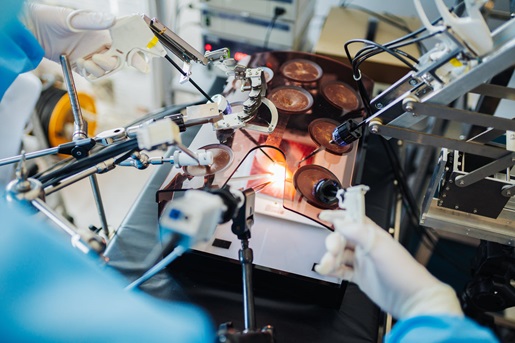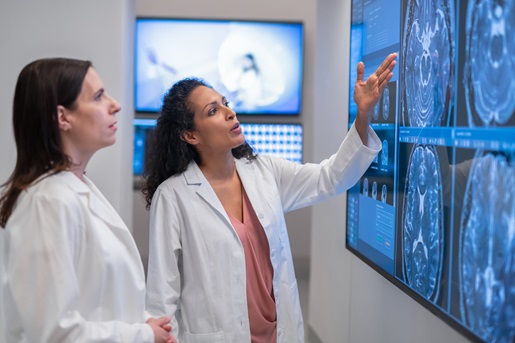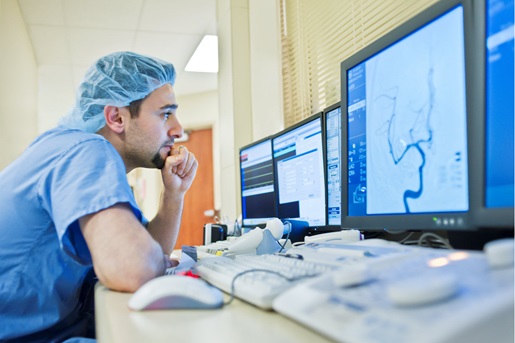How healthcare organizations are using new technology to drive patient success
As the population continues to grow, demand for healthcare grows with it. As a result, healthcare facilities are facing unprecedented staffing shortages. These shortages, combined with the growing role of technology and data in healthcare have led as many as 80% of healthcare organizations to consider the future of AI in healthcare.
As the power and capabilities of AI continue to evolve, the potential roles AI could play in healthcare are expanding. From enhancing diagnostic capabilities to providing new opportunities for education, the future of AI in healthcare seems to be limitless.
Need help picking the right scanner for your transition to AI-powered healthcare? Check out our post, AI in Healthcare: The Complete Guide.
The future of AI in healthcare
In January 2024, the WHO (World Health Organization) published new guidance on the use of AI, including LLMs (large language models). In this guidance, the WHO describes five areas where it sees AI being of particular use in healthcare:
- Diagnosis and clinical care
- Patient-guided use
- Administrative and clerical tasks
- Medical and nursing education
- Scientific research and drug development
Within these categories, the WHO described potential use cases and opportunities for harnessing AI. But it also shared words of caution. The WHO cites the potential for LLMs to produce inaccurate results or “hallucinations.” These hallucinations are a result of flawed logic or the AI ingesting faulty data. The WHO suggests that systems employing AI “not be completely automated.”
In spite of these potential shortcomings, the future of AI in healthcare seems promising.
Did You Know?:TMC named the RICOH fi-8170 as a Future of Work Product of the Year. TMC recognizes "companies that showcase the most innovative and disruptive products and solutions that have positively supported hybrid work experiences across the globe." Click here to learn more.
Diagnosis and clinical care
One of the most exciting areas of opportunity for AI in healthcare is its potential for assisting with diagnosis and clinical care. AI is already assisting with the analysis of imaging to diagnose tumors and other health issues.
One example of how AI can go even further is the UC San Diego prediction tool, COMPOSER. COMPOSER is an AI deep learning tool that monitors patients for the risk of developing sepsis.
Sepsis is an immune response to infection that can lead to severe complications — it is the third leading cause of death in US hospitals.
Several institutions have been testing AI solutions with mixed results. COMPOSER is the latest attempt to use AI to predict and prevent sepsis, and so far it has proved effective.
COMPOSER begins monitoring a patient’s risk for sepsis as soon as they are admitted, tracking over 150 variables. These variables include demographics, medical history, vital signs, current medications, and lab results. If COMPOSER determines the patient is at risk for sepsis, it alerts physicians who then review the data and determine a course of treatment.
UC San Diego tested COMPOSER at two separate Emergency Departments (ED) within the US San Diego Health System. By studying the cases of over 6,000 patients, it was found that COMPOSER reduced sepsis-related mortality by 17% during the testing period.
Patient-guided use
Healthcare systems today are employing a variety of tools to empower patients. One example is the healthcare portal, which gives patients access to their updated records and results
Data science firm Kanini suggests the patient portal could be supercharged with AI to do things like give patients an estimate of the cost of their treatment or provide recommendations for the nearest or most suitable caregiver.
Kanini also suggests that AI could be used to create medical chatbots. These LLM-powered bots would be available to discuss a patient’s symptoms and describe possible treatments. The bot would then walk the patient through their options and recommend the next courses of action if their case needed to be escalated.
A 2022 study found that such chatbots were gaining in popularity. But the researchers found mixed results about their efficacy. While the chatbots studied did reduce screening and triage times, there were questions about their accuracy. This is one area where the further development of the technology could lead to enhancements in the performance of AI.
Administrative and clerical tasks
Administrative tasks account for as much as 30% of healthcare spending. These expenditures include clerical work, accounting, and government and insurance reporting. It is referred to as “the administrative burden,” suggesting that an increased emphasis on value-based metrics and quality initiatives has contributed to an increase in administrative work in recent decades. As with other areas of healthcare operations, the administrative realm is an area where AI is rising to take up some of the burden.
Cedars-Sinai announced their AI priorities in 2024 will remain focused on administrative tasks like optimizing operating room (OR) flow and administrative tasks. To help optimize OR flow, the hospital will use AI to analyze OR usage and predict usage times and availability of surgeons.
On the administrative side, Cedars-Sinai is experimenting with LLMs to craft patient summaries and communications with patients. This has the potential to save physicians considerable time, but it raises questions of accuracy and ethics.
As the vice president of enterprise data intelligence at Cedars-Sinai, Mike Thompson, told HealthITAnalytics:
“Large language models are trained on information. Whether the information is correct or not, it was still trained on that information. How do [health systems] surface that to a physician to say, ‘This information may or may not be accurate?’”
Did You Know?:The RICOH fi-8950 production scanner can scan up to 150 double-sided pages per minute. With a 750-page document feeder and double-sided scanning, the fi-8950 is ideal for large-scale digitization projects. Click here to learn more.
Medical education
The power of AI and LLMs to process large volumes of data quickly makes them a potentially powerful tool for medical students. In the course of their education, students are exposed to mountains of information. Using an LLM, they can quickly find the details that are pertinent to their studies.
The chair of the department of medical education for Mount Auburn Hospital, Jeremy Richards, MD, MA, FACP, ATSF, suggests that educators not fear this tool. Rather, he says, to try to understand it and learn how to incorporate it into the curriculum. He compares the rise of ChatGPT and other LLMs to the days of the early Internet. Professors then feared that easy access to information would cause students to become lazy and not learn the key lessons being presented. Educators today have similar fears about LLMs.
“The key is understanding what this technology can and cannot do and embracing its capabilities,” Richards says. He suggests asking students nuanced questions that require critical thinking as opposed to simple regurgitation of facts. Students may utilize LLMs to gather information, but they would still be required to apply their knowledge to the situation and come up with their own answers.
The WHO suggests AI might be used to create virtual patients that students can interact with. Such a tool might provide critical back-and-forth, teaching not only diagnostic skills but also bedside manner.
However, the WHO cautions that inaccurate answers supplied by AI might lead to faulty future diagnoses. It also cautions that employing AI tools might create a burden for less tech-savvy healthcare workers.
Scientific research
AI’s processing capability allows it to be used to process enormous amounts of data in relatively short amounts of time. This has the potential to empower the advancement of medical research.
Priscilla Chan of the Chan Zuckerberg Initiative put it more broadly, saying, “AI can assist us in analyzing the various types of cells in our body and how they interact — which we believe is key to demystifying disease and helping scientists cure, prevent or manage all diseases by the end of this century.”
One project that has the potential to provide answers to myriad medical questions is the Human Cell Atlas. The project aims to map the functions of every type of cell in the human body. The goal is to understand how these cells behave, interact, and contribute to overall human health.
The Human Cell Atlas is utilizing AI to analyze more data faster than could have been done with previous technologies. It recently mapped human lung cells by analyzing more than 2.4 million cells from around 500 individuals using machine learning. The resulting analysis revealed rare cell types and lung cancer variations and suggested therapies that might be effective at treating multiple diseases.
Our recommendation: RICOH fi-8170
The future of AI in healthcare looks promising, but relies on a steady stream of digitized information. Healthcare professionals looking to invest in the future of AI as part of an overall digitization strategy have no shortage of options. We take great pride in having spent the last 50+ years researching, designing, and developing some of the most advanced and powerful electronics in the world, including our professional grade fi and SP series of scanners.
Built to purpose for the most demanding document handling jobs, fi and SP scanners are capable of processing tens of thousands of pages per day at the highest levels of accuracy. Their intuitive integration capabilities with all existing work suites minimize time-to-value for businesses looking to invest in tools that will pay dividends for years to come.
Healthcare professionals investing in the future of AI will benefit from a range of digitization technologies, like the RICOH fi-8170. Its ability to perform double-sided scans at a whopping 140 pages per minute means it’s ingesting data quickly. And its proprietary Clear Image Capture (CIC) technology delivers images that are clear and correct. This will help ensure your AI has accurate and complete data to learn from. Click here to learn more or shop the rest of our production scanner line.
Note: Information and external links are provided for your convenience and for educational purposes only, and shall not be construed, or relied upon, as legal or financial advice. PFU America, Inc. makes no representations about the contents, features, or specifications on such third-party sites, software, and/or offerings (collectively “Third-Party Offerings”) and shall not be responsible for any loss or damage that may arise from your use of such Third-Party Offerings. Please consult with a licensed professional regarding your specific situation as regulations may be subject to change.









